|
February 14, 2006
Hello from Ottawa: The Canadian War Museum
and Its Special Exhibit " Weapons of Mass Dissemination - The
Propaganda of War"
Anybody who knows me and my
personal family background knows that I absolutely abhor violence
and war. War and conflict has existed all throughout human history
and it has often baffled me that even in this day and age, in our
supposedly advanced civilizations, we still haven’t found
more peaceful ways of coexisting.
My trip to Ottawa this past weekend has been very exciting, entertaining
and enjoyable, yet I felt the impulse to add a more serious stop
to my itinerary and I decided to explore the new Canadian War Museum
and it’s special exhibition: “Propaganda: Weapons
of Mass Dissemination”.
The new Canadian
War Museum opened in May of 2005 in a brand-new building on
the banks of the Ottawa River, about 7 minutes west of downtown
Ottawa by taxi or bus. Its mandate is to “Educate. Preserve.
Remember” and the Museum focuses strictly on Canada’s
role in various armed conflicts throughout history.
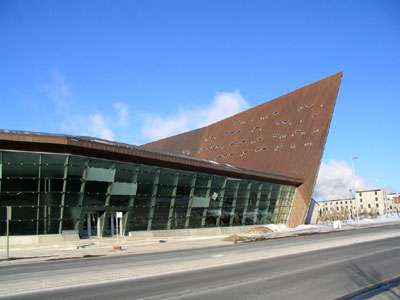
The new museum building is an interesting story in itself. Designed
by Raymond Moriyama of Moriyama & Teshima Architects, the innovative
design of the Museum is based on the theme of “regeneration”,
which not only alludes to the impact of war on the land, but also
Nature’s ability to regenerate itself and recover from the
devastation of human conflict.
In tune with natural regeneration, energy-efficient construction
techniques and recycled materials were used in the construction
of the building. The roof is covered by low-maintenance native,
self-seeding grasses, and river water is used in its cooling system.
Recycled copper panels from the roof of the Library of Parliament
were used as cladding in parts of the interior of the building.
The building is an unusual structure, low-lying with jagged edges
and angular, trapezoidal lines. When you enter inside there is a
large central hall that connects both the south and north entrance.
The building has a raw, fragmentary and unfinished quality to it,
and the materials used include galvanized steel, concrete, wood,
hard surfaces and strong, deep colour. It is not a comfortable,
harmonic place, and it is not intended to be.
An immense seven-meter high audio visual presentation of the Museum’s
content provides a glimpse of what is to come inside the main exhibition
areas. Several features of the building deserve to be highlighted:
- the Museum features Morse Code windows in both English and French,
reading “Lest We Forget” on the north peak, and other
windows spell out the Museum’s initials “CWM”.
- Every November 11, at 11 am, and only on this day and at this
hour, the sun shines through the window of the Museum’s Memorial
Hall and illuminates the only artifact in this space: the headstone
of Canada’s Unknown Soldier.
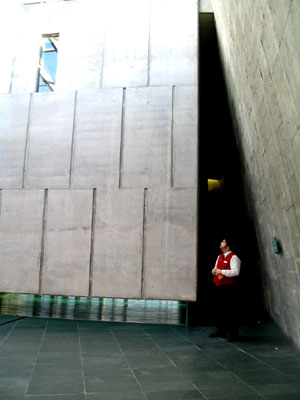
The window illuminating the headstone of Canada's Unknown Soldier
The Museum is very large and its total collection has about 500,000
artifacts. The total artifacts on display in the Canadian Experience
Galleries is 2,167 and there are 135 featured audiovisual productions.
2,000 graphic images reside inside the Museum.
The layout of the Museum is complex and interwoven, creating a
rich, multi-sensory, multi-media visitor experience. It houses 4
Permanent Exhibitions:
Gallery 1. Battleground
This exhibition explores warfare from pre-contact Canada to the
Battle of Batoche in 1885. This section looks at the technology
and equipment of early First Peoples. A major highlight in this
section is the Battle of the Plains of Abraham of 1759 where New
France was conquered and Quebec became a part of Canada. Amazingly
this battle only lasted half an hour, 30 minutes that changed Canada.
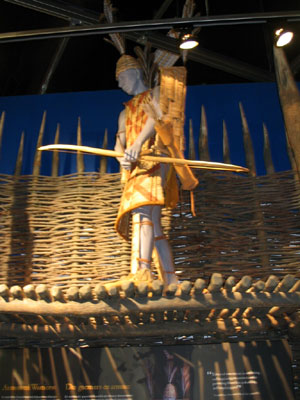
Early aboriginal warfare
Another section in this area illustrates the War of 1812, when
Canada was attacked by the United States and government buildings
in the City of York (now Toronto) were burnt down by the Americans.
In retaliation British Canadian militia marched all the way to Washington
and burned the American's official buildings which had to be whitewashed,
therefore the term “White House”.
Different outcomes of two consecutive rebellions in 1870 and 1885
in Manitoba and Saskatchewan illustrate the key difference of new
technologies: while the first rebellion was successful, the second
uprising was quelled easily due to the introduction of the railroads,
which allowed for rapid troop deployment, better training of the
government troops and the introduction of the telegraph which allowed
for rapid communication. Other technological innovations of this
era included the Gatling gun which was capable of 800 shots a minute,
the first automatic weapon.
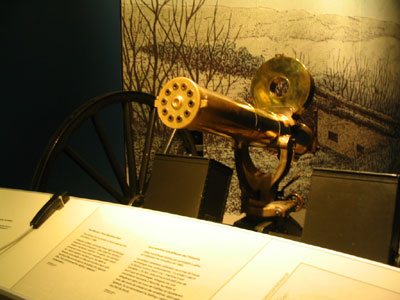
Gatlin Gun
Gallery 2. For Crown and Country
This gallery explores Canada’s military involvements overseas.
It looks at the South African War (also known as the Boer War, from
1899 to 1902), and the Second World War from 1914 to 1918.
A significant technological development during the South African
War include rifles that could fire accurately at a distance of up
to 800 m. British soldiers, who had earlier been wearing red tunics,
had to switch to camouflage uniforms due to the increased reach
of modern weapons. The time of traditional British formation battles
was over.
Canada’s land forces were among the most effective during
World War I and an important section is dedicated to the critical
battle of Vimy Ridge. My tour guide Eric mentioned that the First
World War was initially a very popular war and that after the declaration
of war in July of 1914, Canadian soldiers even expected to be home
by Christmas. 1 of 8 Canadian men joined the war and interestingly,
conjugal consent was required to enlist for married men.
Support for the war dwindled as time went on and as people learned
about the devastating effects of trench warfare which are illustrated
effectively in the Museum. An interesting social side note is that
in order to enact conscription, i.e. mandatory military service,
the Canadian government extended a limited voting right to women
in 1917, but only to women whose sons and husbands were fighting
in the First World War. These women would logically vote in favour
of the existing government as they wanted to send support to their
husbands and sons fighting in the war. General voting rights were
not extended to all women until 1919.
A powerful exhibit includes an outright scene of devastation that
shows a recreated landscape after a devastating battle where all
surrounding structures have been destroyed and soldiers are lying
dead face-down in the mud of the battlefield.
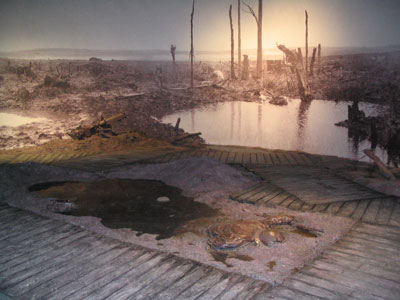
Utter devastation
My guide Eric also enlightened me on the Halifax explosion of 1917
when two ships collided in the Halifax harbour and one carried huge
amounts of ammunition. This event represents the largest man-made
explosion prior to the atomic bomb and much of Halifax was levelled.
Another exhibit displays gas masks used during World War I. When
German soldiers used poison gas for the first time, French and British
forces broke their own lines to escape, while a chemist on the front
lines of the Canadian army realized that chances of survival could
be increased by putting something humid on one’s face. As
a result Canadians held their grounds in the face of gas attacks,
contrary to the French and British counterparts.
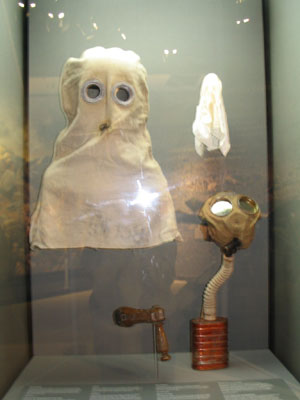
Early gas masks
World War I also saw many technological innovations such as artillery
canons and water-cooled machine guns. As a result of this heavy
equipment, soldiers became less mobile and trench warfare came into
being.
Gallery 3. Forged in Fire
This gallery explores Canada’s role in fighting dictatorships
overseas during the Second World War. Canada contributed one of
the largest armies in the world, on land, at sea and in the air
in addition to providing important industrial and logistical support.
A key artifact in this section is one of the last remaining parade
cars of Adolf Hitler, an armour-plated black Mercedes convertible
with bullet-proof windows, apparently the only one of its kind in
existence in a public museum.
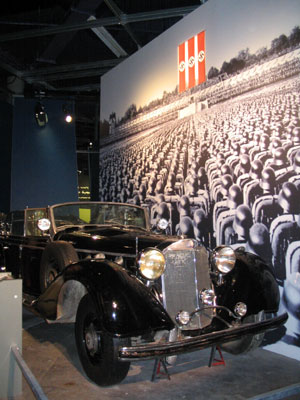
Hitler's Mercedes convertible
My guide also pointed out the Wasp flamethrower which could generate
flames of 90 m in length. To give you an idea of the size of these
flames: the Peace Tower of the Canadian Parliament Buidlings is
92 m high, so this was indeed amazing firepower.
Particularly interesting exhibits from this era include a battlefield
surgery kit that illustrates how primitive medical equipment and
techniques were at this time. Another highlight is the pigsuit,
a full body suit for pigs that was intended to investigate the protective
capabilities of uniforms under wartime conditions. Pigs were used
for this purpose as they have very similar genetic makeup to human
beings.
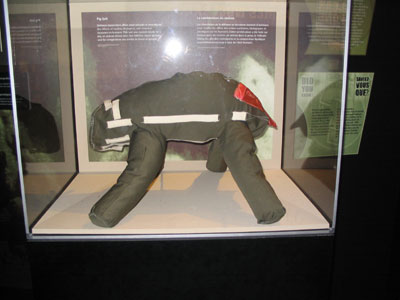
Pigsuit
Gallery 4. A Violent Peace
This section of the Museum looks at the tenuous peace during the
post-WWII Period where Canadian forces participated in a Cold War against the Soviet Bloc. During this era, Canada also took on a
leading role as an international peacekeeping nation, a role from
which Canada derives great pride.
The post-war era of the 1950s and 1960s was an era of great paranoia.
A machine called an “electro-psychometer” (similar to
a lie detector) was employed to determine the sexual orientation
of civil servants. In this very conservative era homosexuality was
a taboo and it was assumed knowledge of that fact could be used
against an individual and force this person to collaborate with
the enemy. The government intended to protect itself and subjected
hundreds of civil servants to tests on this notoriously unreliable
device, also referred to as the “fruit machine”.
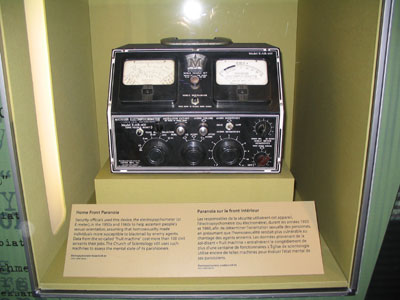
The Electro-Psychometer, a.k.a "The Fruit Machine"
One of the exhibits also explains the origin of the notion of modern
peacekeeping, brought to life in 1956 by Canadian Prime Minister
Lester B. Pearson, who received a Nobel Peace Prize for his contributions
in 1957.
To me one of the most amazing exhibits in this area is a controversial
painting depicting a Canadian soldier abusing and killing a civilian
victim during a peacekeeping mission in Somalia. My guide indicated
that many people in the Canadian military did not appreciate that
this painting was being displayed, and in many countries this kind
of unflattering depiction of a member of a national army would have
been censored. It truly speaks to Canada’s openness and honesty
that this picture was included in the exhibition as a testament
to the devastating and dehumanizing effects of war.
Regeneration Hall:
This section was not part of the original concept of the building,
it was added by the architect himself. Through a narrow window one
can see the Peace Tower, and any slight change in position will
make this view disappear. This is a symbolic metaphor for how difficult
peace is to achieve and how easily we lose sight of it. Plaster
statues in Regeneration Hall were created by the same artist who
created the Vimy Memorial. The eerie sound in this portion of the
building is the recording of the wind that used to come through
the steel girders before the roof was put on. A tour of war veterans
came through Regeneration Hall, heard this strange sound of the
wind and they were very moved by it. The museum officials decided
to record the sound and run it continuously.
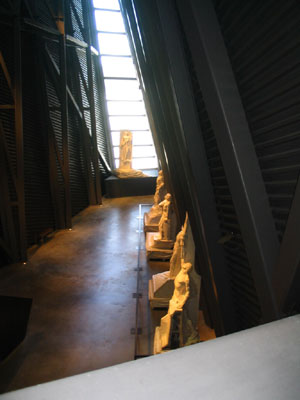
Regeneration Hall
The Royal Canadian Legion Hall of Honour
This centrally located section of the Museum contains artifacts,
works of art, and other traditional display media to honour and
remember Canadian history.
The LeBreton Gallery
One of the world’s best collections of military vehicles and
artillery are exhibited in the LeBreton Gallery. Furthermore, it
features an important collection of uniforms, medals and other artifacts.
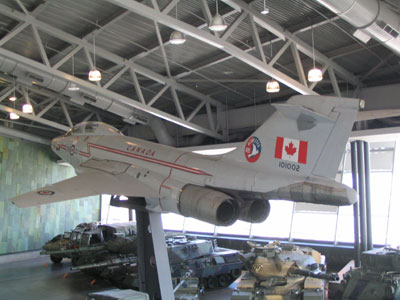
LeBreton Gallery
Special exhibitions in the Lieutenant-Colonel
John McCrae Gallery
In addition to these permanent exhibitions and commemorative places,
the Canadian War Museum houses special exhibitions. One of the main
reasons I went to visit this museum was to see an exhibition called
Weapons of Mass Dissemination: The Propaganda of War.
The psychological aspects of warfare, and in particular the tools
and techniques of propanda to mobilize and incite the general population
to participate in war have always fascinated me. I could have spent
hours in this part of the Museum alone, and this collection has
been one of the most fascinating exhibitions I have visited in my
entire lifetime.
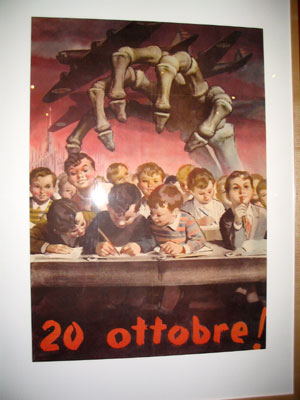
The term “propaganda” itself is defined as the “organized
dissemination of information to influence thouths, beliefs, feelings
and actions”.
The exhibition was originally developed by the Wolfsonian-Florida
International University and highlights visual propaganda tools
used in the United States, Canada, Mexico, Germany, France, Italy,
Spain and Holland. Propaganda posters date back to the First and
Second World Wars, as well as the Spanish Civil War.
Numerous colourful posters from different countries illustrate
the powerful impact of war-time propaganda and its powerful impact
on the masses. Emotional headlines, bright colours and strong symbolism
evoke powerful feelings fear, anger, pride and patriotism.
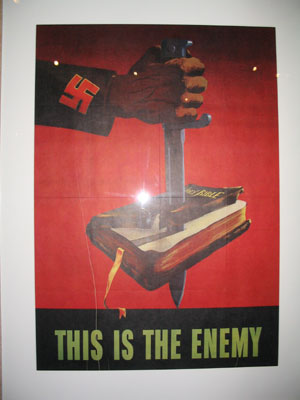
Here are a few examples of how nations engaged in war use propaganda
posters:
- to exhort men, and even women and members of different ethnic
groups to join the army [“There is still a space for you in
the Waffen SS”]
- to promote the purchase of war bonds [“I buy bonds and I
build bombs”]
- to increase production and output of military equipment
- to reduce the civilian onsumption of tobacco products so soldiers
can enjoy smoking
- to plant seeds and vegetables to create oil for the hungering
masses
- to portray the enemy in the most negative way, using unflattering
and threatening images
- to warn the population of “careless talk” implying
that foreign spies could pick up important information and use it
against the nation
- to instruct soldiers and the population in the use of protective
equipment such as gas masks
In addition to the posters from the Wolfsonian – Florida
International University, the Canadian
War Museum has added a Canadian component to add to this exhibition.
The development of propaganda in Canada is featured in the form
of posters from the Museum’s collections, footage from the
National Film Board, as well as special hands-on programming. Screenings
of NFB propaganda films, creative workshops and a popular speaker
series round out the programming on the topic of mass media and
propaganda.
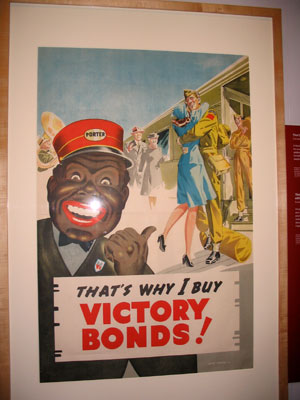
My two hours at the Canadian War Museum definitely weren’t
enough, I was just able to get a cursory glance at the permanent
exhibitions and this most fascinating special exhibition on wartime
propaganda. It is one of the most impactful museums I have ever
visited, and the combination of the layout and design with the artifacts
on display have given me an excellent overview of Canada’s
role in local and international conflicts.
Related Articles:
Hello from Ottawa
- My 2-day packed itinerary for Winterlude
Hello from Ottawa - First
impressions and an overview
Hello from Ottawa - The Lord Elgin
Hotel: a historic landmark in the heart of Ottawa
Hello from Ottawa - Fat Tuesday's
and the Mardi Gras Experience in the ByWard Market
Hello from Ottawa - An early
morning walk to Parliament Hill
Hello from Ottawa - Skating
on the Rideau Canal, the World's Largest Skating Rink
Hello from Ottawa - Charity and
hilarity: the 26th Annual Bedzz Races on Dow's Lake
Hello from Ottawa - Confederation
Park and other Winterlude locations
Hello from Ottawa - Darcy McGee's:
a historic Irish pub on Sparks Street
Hello from Ottawa - The Canadian
War Museum and "Weapons of Mass Dissemination - The Propaganda
of War"
Hello from Ottawa - The
Canadian Museum of Contemporary Photography featuring Sunil Gupta
and the challenges of immigration
An interview with Tourism Ottawa
provides a great overview of this city
An interview about
the ByWard Market, a prime entertainment and shopping area
An interview
with the National Gallery of Canada
An interview
with the Canadian Museum of Civilization
Helpful websites:
Ottawa
Tourism: Ottawa's official tourism information
The ByWard
Market Business Improvement Area
The
National Capital Commission
The National
Museum of Civilization
The National Gallery
of Canada
The Canadian War
Museum
Useful books about Ottawa:
|